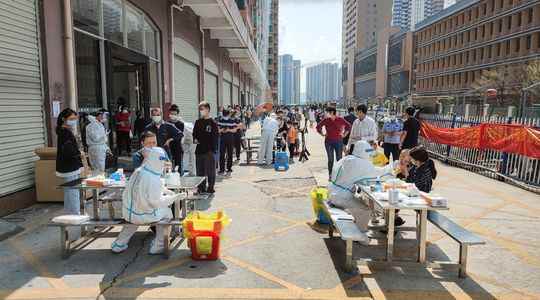Faithful to its “zero Covid” strategy, China continues to use drastic measures in the face of the rebound in the Covid-19 epidemic. The Canton fair, one of the largest commercial events in the world, in the southeast of the country, was canceled after it was discovered that a sick person – just one – had visited the fair.Immediately, barriers were erected around the vast complex and all of the 50,000 visitors present that day were A compact crowd, isolated in a parking lot, who will have been standing for more than six hours before being able to leave the area.
Some are less fortunate, like this young secretary from Shenzhen – 17 million inhabitants now confined – who says she had to sleep in her office for 48 hours after a patient was spotted in her skyscraper. “I had not anticipated that we could be locked in place, without a blanket, without toiletries or a shower, she testifies. It was very stressful, I was able to go home but we are now stuck in our apartments until further notice”.
China is currently experiencing its most spectacular epidemic wave in two years. She announced, this Tuesday, March 15, 5,280 cases, double the figure announced the day before. More than 30 million people are already confined – at home, or in hastily built prefabs like in Jilin where a 5,000-bed quarantine center sprouted in hours.
Unheard of since the images of the drastic containment of Wuhan, shortly after the start of the pandemic, which had stunned the world. The inhabitants of Shenzhen, Changchun (9 million), but also Jilin, Qingdao and entire districts of Shanghai, the Chinese economic capital, are now blocked at home. Schools are closed and, in Shenzhen, public transport is at a standstill. Inter-provincial travel is prohibited and 19 out of 35 provinces are classified as risk areas.
In Beijing, residents are holding their breath. “Every day the number of sick people increases, says a resident of the north of the capital. I started to stock up on food, you never know what can happen, I am afraid that we will find ourselves locked up like two years ago, it’s horrible to have to go through that again”.
In confined towns, only one person per household is allowed to go out, once every two days to look for supplies. The neighborhood committees, zealous volunteers of the Communist Party, are mobilized to monitor the QR tracking codes, control movement and the wearing of masks.
The arrival of Omicron, much more contagious than the previous variants, is a challenge for China, which had so far succeeded in stopping the circulation of the virus, barricaded behind its great health wall. “We must do everything to stop this new wave” launched the Chinese Center for Disease Control and Prevention. The CCDC estimates that the repeal of the “zero Covid” policy, which China is the last country to apply, would lead to the death of two million people in one year. A conclusion that some observers consider alarmist. “It is essentially an internal document intended to support government strategy,” explains Jaya Dantas, professor of public health at the University of Perth (Australia).
A test for the diet
“We thought that Covid could be essentially contained through vaccines, explains the chief epidemiologist of the CCDC, Wu Zunyou, but it now seems that there is no simple method to control it, except by global measures”.
It must be said that the only two Chinese vaccines authorized on the territory, that of Sinovac and Sinopharm, are very ineffective against this new variant and only 40% of vaccinated people have received a third dose. Some consulates, such as that of Spain, organize the vaccination of their nationals. And representatives of the French community are asking the authorities to send them messenger RNA vaccines. “But it would be too complicated, there are many more French than Spaniards in China and the Chinese authorities do not authorize foreign vaccines”, confides a diplomat.
For the communist regime, this is a real test. Since April 2020, the government has been trumpeting its “victory” against the epidemic and brandishing it as proof of the superiority of its system over that of Western democracies. But this “zero Covid” strategy has a cost: unemployment has risen since the start of the year and small businesses would not recover from a second generalized confinement.
In Shenzhen everything is already closed: bars, restaurants, shopping centers and even factories, such as those of Foxconn, subcontractor of Apple, DJI (drone manufacturing) and Huawei (telecommunications). Half of the planet’s iPhones are produced in Shenzhen, as is most of China’s semiconductor production, raising fears of shortages in a sector already affected by logistical problems.
“The fear of an epidemic on the eve of the 20th Congress of the Communist Party of China next fall is real, and constitutes a major political challenge,” said Li Ming Jiang, professor of political science at Nanyang University in Singapore. In a few months, Xi Jinping should obtain a third mandate, unseen since Mao. But discontent is rising, in this politically very sensitive period, when the regime fears destabilization. Many Chinese are tired of living confined within national borders. Quite a symbol, no new passport has been issued for months.
“All this is likely to last for a long time, probably until the end of 2022, believes a European consular representative. As a result, more and more expatriates are leaving China and cannot be replaced”. The number of French expatriates in the country has halved in ten years and this new wave should carry away the last hopes of a rapid return to normal life.
